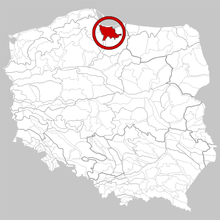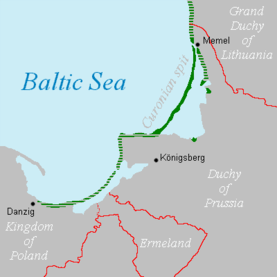Żuławy Wiślane

Żuławy Wiślane (fens, plural from "żuława") is the alluvial delta area of Vistula, in large part reclaimed artificially by means of dykes, pumps, channels (over 17000 km of total length) and extensive drainage system. In shape similar to reversed triangle formed by branching of Vistula into two separate rivers, Leniwka and Nogat at its height, confined by rivers themselves, and closed by Mierzeja Wiślana at its base. It is a deforested, agricultural plain that covers 1000 square km.
Etymology
There is no definite statement for the origin of name "Żuławy". Term is believed to be derived from word "solov" in language of the Baltic tribe Prussian or Polish noun "żuł" for mud.
History
Prehistory and initial settlement
The first traces of settlements reach back to the period between 2500 and 1700 BC, being proved by excavation sites from Niedźwiedziówka, Lubieszewo, Ostaszewo, Kaczynos, Kończewice, Krasnołęka, Lasowice Wielkie or Lichnowy. They appear to have been of impermanent form as they served presumably for fishery and amber acquirement. The range and density of settlements had not changed in a course of the next centuries until around the ninth century, when emergence of the Baltic tribe Estowie boosted occupation of Żuławy Wiślane. One, the best known is Truso, a large fishery-trading center in present Janów Pomorski near Elbląg. Before the thirteenth century population was generally restricted to morainic heights around the delta, in the surroundings of Gdańsk, Miłobądzu, Gorzędzieju, Lichnowach and Węgrach (the Slavic people), and alongside lake Drużno and Wysoczyźnie Elbląskiej (for Old Prussians).
Expansion
In the 13th century by contrast, the local population experienced a rapid growth brought about by mixed Slavic-Prussian colonization. In effect, new villages had emerged, and from them many have survived up to now under unchanged names. In a space of one hundred years, the Slavic settlements reached the line Płonia Wielka, Cedry Wielkie, Ostaszewo, Lubieszewo, Świerki, Malbork. On the other hand, Żuławy Wiślane drew numerous Dutch and German immigrants.
After the Partitions of Poland

In the aftermath of the Second Partition of Poland in 1793, Żuławy Wiślane were incorporated into the Prussian Kingdom as two districts: Danziger Niederung and Danziger Höhe. After Poland regained independence in 1918, Żuławy neither stayed in Germany nor were included in the new Polish state; instead, they became part of the Free City of Danzig. When Hitler came into power in Germany, the Free City of Danzig in due course fell into the influence zone of Germany. When World War II was finally over, Żuławy Wiślane was turned over to the Polish state in 1945. Almost all of the German inhabitants have been expelled, and the region has been resettled with Polish people.
Kursenieki

While today the Kursenieki, also known as Kuršininkai are a nearly extinct Baltic ethnic group living along the Curonian Spit, in 1649 Kuršininkai settlement spanned from Memel (Klaipėda) to Danzig (Gdańsk), including in the area of the Nemunas Delta. The Kuršininkai were eventually assimilated by the Germans, except along the Curonian Spit where some still live. The Kuršininkai were considered Latvians until after World War I when Latvia gained independence from the Russian Empire, a consideration based on linguistic arguments. This was the rationale for Latvian claims over the Curonian Spit, Memel, and other territories of East Prussia which would be later dropped.
Geography
Żuławy is traditionally divided, according to the historical ownership, into:
- Żuławy Gdańskie - the western part, from Gdańsk to the Vistula
- Żuławy Malborskie or Żuławy Wielkie (Greater Zulawy) - the part between Vistula and its right arm Nogat
- Żuławy Elbląskie - on the eastern bank of the Nogat.
Terrain seems to look strikingly flat, but a topographic map states otherwise. For instance, land slopes down at some points below sea level. Depressions account for 28% of the overall area of the delta. The lowest point, 1.8 m below the surface, is located by Jezioro Drużno, at the state road 22 between Elbląg and Malbork in Raczki Elbląskie, making that terrain the lowest point in Poland. Second in size depression land area is placed around Nowy Dwór Gdański.
Surface water has lost its unique character due to impact of human activity. Water does not flow as freely as in other parts of the country, because most of the water is on equal altitude, and in fact its circulation is carried out artificially.
(..) Centuries of human activities are visible in the thousands of kilometers of canals and drainage ditches, a dense drainage network, the banking up of the rivers, pumping stations and the formation of a system of polders. In effect, the natural environment underwent such transformation that it would be difficult to find any fragments, which remain unchanged." (B. Augustowski, Żuławy Wiślane, Gdańskie Towarzystwo Naukowe, Gdańsk 1976)
References
- Żuławy Wiślane - Informator Krajoznawczy (Demart, Warszawa, 2004
- Changes in the area and depth of the depression in Zulawy Elblaskie, Joanna Fac-Beneda, Peribalticum VIII, Gdańskie Towarzystwo Naukowe, Gdańsk 2000
- Żuławy Wiślane (Gdańskie Towarzystwo Naukowe, Gdańsk 1976)
- Pomorze Gdańskie vol.3 - Żuławy Wiślane (Gdańskie Towarzystwo Naukowe, Gdańsk 1966)